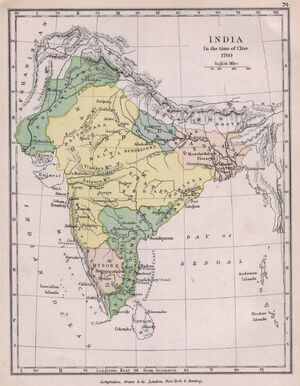
India during the Seven Years' War.
India is a country in South Asia with a history dating back nearly 5,000 years. When Portuguese traders began establishing trading posts in the 16th century, most of India was under the control of the Mughal Empire. Portuguese traders were followed by others from the Netherlands, Great Britain, and France. In 1617 the British East India Company was given permission by the Mughal Emperor Jahangir to trade in India.
Over the course of the 18th century the Mughal Empire went into decline and was replaced by the Maratha Empire. At the same time, British and French traders began to support rival claimants to the thrones of the Indian states of Hyderabad and Arcot. During the Seven Years' War, the French were defeated at the Battle of Plassey in June 1757 by Robert Clive at the head of a Bengali army. The Company appointed Clive as its first Governor of Bengal that year, and by the time of the Treaty of Paris in 1763 the Company had gained exclusive control over the entire Carnatic region of India. After the Battle of Buxar in 1764 the Mughal Emperor Shah Alam II granted the Company rights of administration in Bengal, which marked the beginning of formal Company rule over Indian territory. Early in the 19th century, British rule extended over all of India.
An increase in cotton cultivation in India in the 1830s contributed to a worldwide cotton glut that drove down prices at the same time that the Panic of 1836 depressed the economies of the nations of Europe and the Americas. Although the economic depression caused by the panic had run its course by the early 1840s, the price of cotton remained depressed for the next 30 years.
By the turn of the 20th century, political developments in India had advanced to the point where the colony became one of the founding members of the United British Commonwealth of Nations in 1906. By the 1930s Indian political autonomy had advanced to the point where Minister for Foreign Affairs Courtney Judd of the Confederation of North America predicted in 1933 that in the event of war between Great Britain and the Germanic Confederation, India would refuse to fight alongside the British.
When the British and Germans did go to war in 1939, India was indeed drawn into the war in late 1940 when the Germans launched an invasion of India. The Germans succeeded in conquering India by the end of 1941, with Pondicherry falling in early December. The German armies then proceeded to advance into Indochina and Indonesia in 1942, but a series of military defeats in those areas, combined with a massive civilian uprising in Europe, forced the Germans to withdraw to positions in India in 1945. The following year, under newly-elected German Chancellor Heinrich von Richter, all but token German forces withdrew from India.
Sobel does not indicate whether India has remained within the German sphere of influence since the Global War, or whether it has rejoined the United Empire. His failure to mention the country's role in the War Without War argues against the latter.
In For All Nails, it is suggested that India has fragmented since the Global War, and that the Indian successor states are involved in a proxy war between the German Empire and the United Empire.
